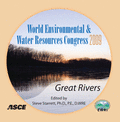Looking Upstream and into the Watershed for the Big Picture of Stream Health
Publication: World Environmental and Water Resources Congress 2009: Great Rivers
Abstract
When examining impaired river reaches, the primary focus is improving streamwater quality in the reach and downstream. The degree of damage to the river channel, the biological functions, and the river chemistry are assessed and restoration plans implemented. Few examine the causes of the degradation from upstream and upland areas and manage those problems before performing restoration work downstream. Without watershed management in the upper river system that addresses the stream's stressors, any restoration downstream becomes useless either relatively immediately or over time. Continued and potentially increased high peak flows from development during storms can wash out many restoration elements. Here, we examine the water management in the upper watershed of an unnamed tributary that passes through the Penn State Harrisburg campus, empties into the Susquehanna River, and eventually into the Chesapeake Bay. We also demonstrate the linkages between the lack of integrated water management and the current status of this tributary. The biota within the stream and surrounding the stream lack both diversity and richness. The streambanks are highly eroded and unstable. Current practices on campus (irrigation, grass cutting, etc.), as well as in the agricultural, residential, and industrial areas upstream, and any future campus development can hinder improving the stream's health. As restoration is being planned and implemented, the fact that this is an educational institution allows us to assess the stream's physical, chemical, and biological health both during dry-weather and wet-weather flows, as well as before and after restoration. We plan to evaluate whether on-land restoration and improved stormwater management will affect the effectiveness of in-stream and stream buffer activities. We also plan to continue both biologic and chemical health evaluations of the stream as a function of land-use improvements. This project has supported several years of both undergraduate and Masters'-level research.
Get full access to this article
View all available purchase options and get full access to this chapter.
Information & Authors
Information
Published In
Copyright
© 2009 American Society of Civil Engineers.
History
Published online: Apr 26, 2012
ASCE Technical Topics:
- Biological processes
- Buildings
- Chemicals
- Chemistry
- Ecological restoration
- Ecosystems
- Environmental engineering
- High-rise buildings
- River engineering
- River systems
- Rivers and streams
- Stormwater management
- Structural engineering
- Structures (by type)
- Waste management
- Water and water resources
- Water management
- Water treatment
- Watersheds
Authors
Metrics & Citations
Metrics
Citations
Download citation
If you have the appropriate software installed, you can download article citation data to the citation manager of your choice. Simply select your manager software from the list below and click Download.
